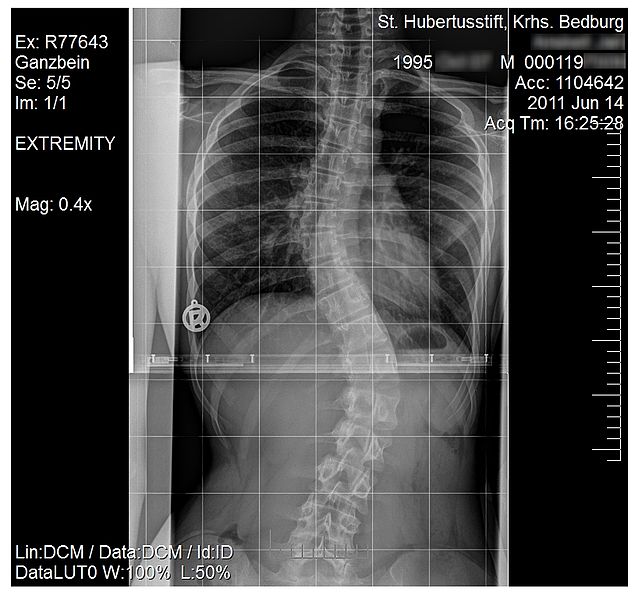
Source: Wikipedia
What is Scoliosis?
Scoliosis is a curvature of the spine that usually occurs in children during growth spurts. The spine will curve to the left or the right and cause various health and posture problems if gone untreated.
It is a fairly common thing with children and adolescents, more so in girls than in boys. 2-3% of the population currently has scoliosis and the numbers are rising. With this increase, it’s important that parents and adults know how to spot scoliosis early.
What Are Some Symptoms of Scoliosis?
If you suspect that your child has scoliosis, here are some common signs that you can look for:
- Uneven Shoulder Height. One shoulder will dip down further than the other. This should be pretty easy to spot with the naked eye, but if you can’t tell, use a measuring tape.
- One Shoulder Blade is More Prominent. If you can see one of their shoulder blades sticking out from their back more than the other, this may be a result of scoliosis. If you can’t tell when they’re standing up straight, have them reach down to touch their toes. This will make it easier to notice if there is an issue.
- Arms Hang to Uneven Lengths. One arm may appear to reach farther than the other. The issue, of course, is not really that the arm is longer, but that the shoulder is dipped lower. You can easily see this by holding a yardstick or a similar tool level with the tips of the fingers on one hand to see if the other hand falls at the same point.
- Hips are Tilted to One Side. One hip is held higher than the other hip. This usually appears inversely from the shoulders. If the left shoulder is dipping low, the left hip will be held high. This is because the spine is curving to the right. Again, you can use a measuring tape to see where the hip falls or hold a yardstick level across the hips to see if they fall at different heights.
- Head Appears to be Off-Center. Because the curvature of the spine has caused an imbalance in the shoulders and pelvis, the head will appear to be off-center from the rest of the body.
- Back has an Asymmetrical Appearance When Bent Forward. When the child bends forward, it will seem like they have a hump to one side of their back. This is different from the prominent shoulder blade, but the two signs will exaggerate each other. If it seems like the back is sloping to one side, that’s a good signal that there may be spine curvature.
How is Scoliosis Treated?
Scoliosis can be treated by using a back brace while the child finishes growing, or by getting surgery that fuses the spine together. If their scoliosis can be treated with the back brace, that option should be explored first. It’s less invasive, less costly, and helps to correct the problem in a way that will allow a fuller range of mobility in the years to come.
The period of time for which a child would need to wear a back brace depends on the severity of the curvature and how much the child still needs to grow. They may wear a back brace for only a year or two, or they may need it for five or six years.
There are two categories of braces that are typically used. These categories are orthotic and orthosis. An orthotic brace improves the function of the spine and is meant to move more with the body. Orthosis braces are more rigid and may be used to limit the movement of the spine.
Within those two categories, there are a lot of different braces to choose from. The type of brace that a child needs depends on their individual situation and the practice of the health care facility that they visit. Healthcare weekly has a great breakdown of what these different scoliosis braces look like and what their purposes are.
Conclusion
If you suspect that your child has scoliosis, start by reviewing the list of signs that was provided in this article. If you feel that these signs are present or if you still aren’t sure, it’s a good idea to take them to a doctor’s office and have them checked by a professional. They will likely take an x-ray and maybe even an MRI or CT, depending on the situation.
The best thing you can do to correct scoliosis is to catch it early and start correcting it at a young age. It will save your child from further complications and surgeries.